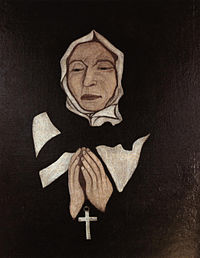Marguerite Bourgeoys
| St. Marguerite Bourgeoys, C.N.D. | |
|---|---|

Portrait by Pierre Le Ber (1700)
|
|
| Foundress of the Congregation of Notre Dame | |
| Born |
17 April 1620 Troyes, Champagne, Kingdom of France |
| Died | 12 January 1700 (aged 79) Fort Ville-Marie, New France, French Colonial Empire |
| Venerated in | Roman Catholic Church (Canada and the United States), Anglican Church of Canada |
| Beatified | 12 November 1950 by Pope Pius XII |
| Canonized | 31 October 1982, Vatican City by Pope John Paul II |
| Major shrine | Notre-Dame-de-Bon-Secours Chapel in Montreal, Canada |
| Feast | 12 January |
| Patronage | against poverty; loss of parents; people rejected by religious orders |
Marguerite Bourgeoys, C.N.D., was the French founder of the Congregation of Notre Dame of Montreal in the colony of New France, now part of Québec. She lived in Fort Ville-Marie (now Montreal) as of 1653, educating young girls, the poor, and natives until her death at the turn of the 18th century. She is also significant for developing one of the first uncloistered religious communities in the Catholic Church. She has been declared a saint by the Catholic Church.
Marguerite Bourgeoys was born in Troyes, then in the ancient Province of Champagne in the Kingdom of France, on 17 April 1620. The daughter of Abraham Bourgeoys and Guillemette Garnier, she was the seventh of their thirteen children. Marguerite came from a middle-class and socially connected background, her father being a candle maker and coiner at the royal mint in the town. Her father died when she was very young, and her mother followed when Marguerite was 19.
In her early years, Bourgeoys had never held much of an interest in joining the confraternity attached to the monastery in the town of the canonesses regular of the Congregation Notre-Dame, which had been founded in 1597 by the Blessed Alix Le Clerc, C.R.S.A., dedicated to the education of the poor. The canonesses of the monastery helped the poor, but remained cloistered and did not have the right to teach outside of the cloister. To reach poor young girls who could not afford to be boarded within the cloister as students, they relied upon the confraternity, whose members they would educate in both religion and pedagogy. It seems, however, that she had a change of heart on 7 October 1640, during a procession in honour of Our Lady of the Rosary. Her response to this experience was to seek to give herself wholly to God and to live a life that mirrored, as much as possible, that of the Virgin Mary.
...
Wikipedia
